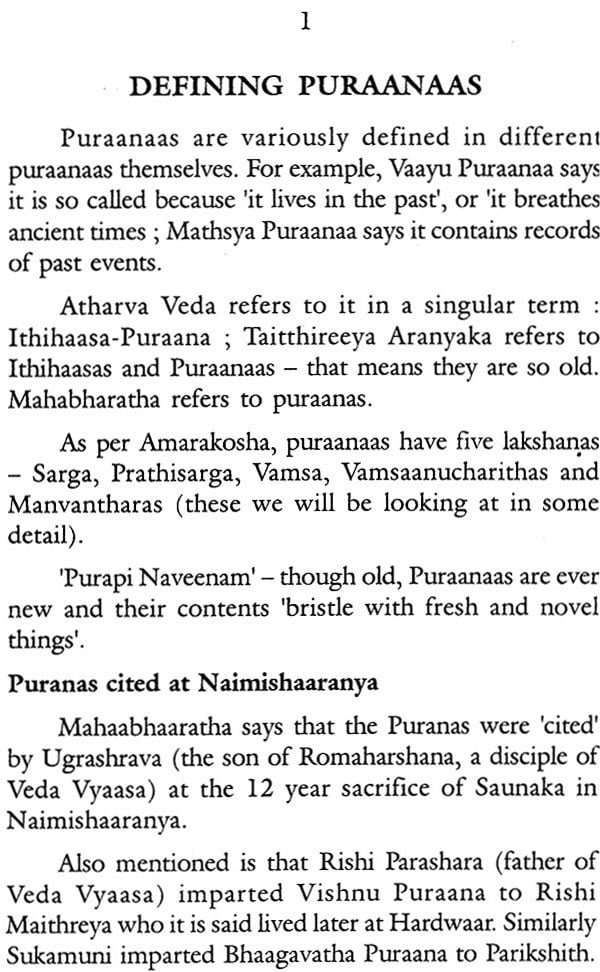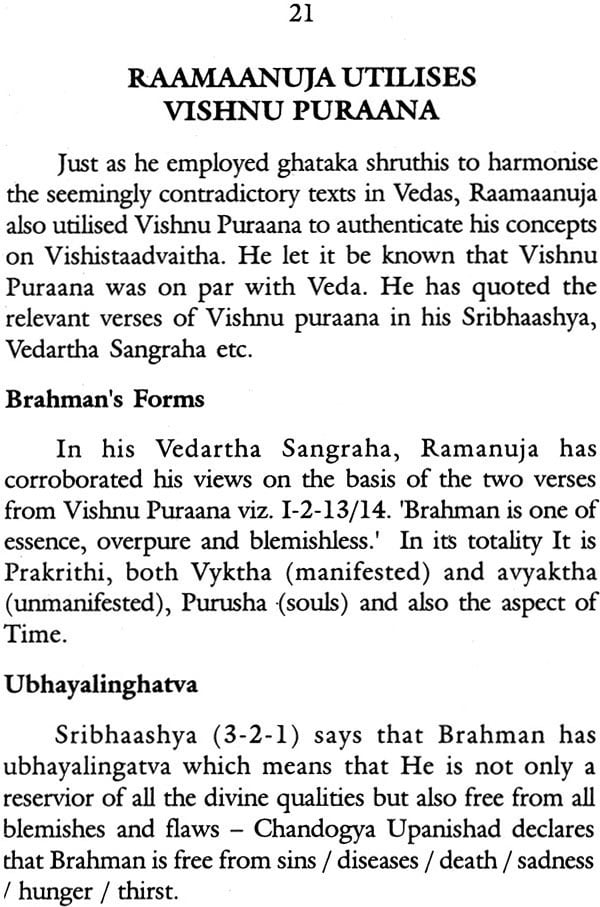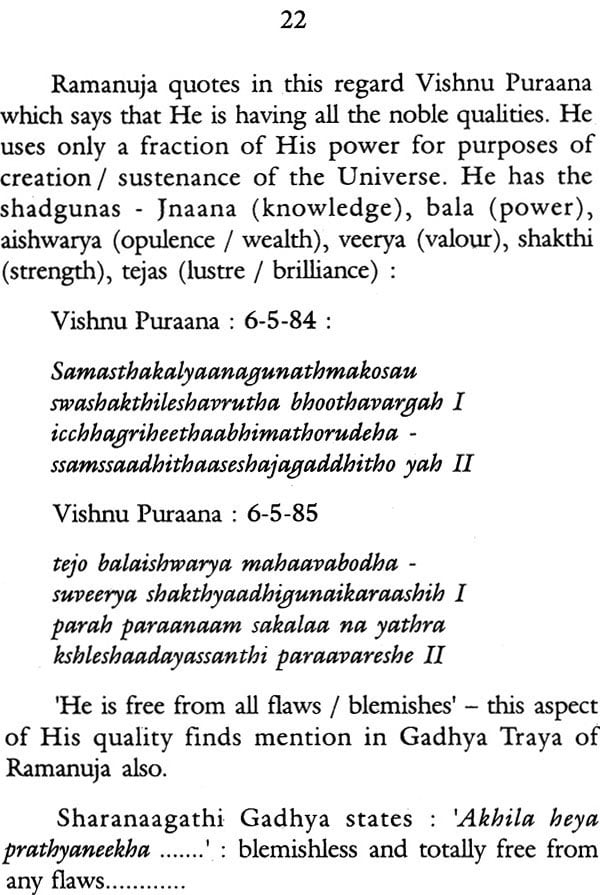
The Saathvic Six and The Nuggets in Puranas
Book Specification
| Item Code: | NAM676 |
| Author: | K. R. Krishnaswami |
| Publisher: | A & K PRAKASHANA |
| Language: | English |
| Edition: | 2008 |
| Pages: | 44 |
| Cover: | Paperback |
| Other Details | 7.5 inch X 5.0 inch |
| Weight | 40 gm |
Book Description
Book on ‘Subject Familiarisation’,
The Series of books on the subject familiarisation started about 8 years back has covered quite a good ground particularly w.r.t. Philosophic subject such as Sribhaashya, Geetha Bhaashya, Vedas, Upanishads, Rahayatrayasaara,, Gadhya Traya, Agamas, Thiruvoimozhi etc. and it is satisfying that this circle is now completed with the present publication on the subject of puraanaas.
Puraanaas are quite a neglected subject and very few books get written on it one only hears o Bhaagavatha puraana which is popular only in some parts of the country . Although puraanaas mean ‘old legends’ their contents are over fresh (naveenam). This aspect is discussed further.
The relevance of puraanaas to modern Times
The Keyword, here qualifying the subject of Puraanaas are the ‘relevance and ‘modern times’ In Other words, the words together mean the usefulness at the present moment’. There is this oft-heard rubbishing: stop it , enough of your puraana’ – the listener is probably fed up with one’s narration frequently of the same story which holds no more interest for the listener. A bad publicity indeed for puraanas !
The term puraanas initially meant ‘puraanam akhyaanam’ – ‘an old legend’ or ‘an old narrative’, but puraanas have a district role in that they fill the gap left by Vedas, and in fact are even called the fifth veda.
If one familiarises himself with the contents, even barely, it will be seen that subjects such as primordial creation of the Universe or its dissolution, or the genealogy of gods, it would hold some interest to the readers. He may not as much bother about manu’s cycles or legends about royal families.
Further one would find it extremely interesting to learn about the greatness of Tulasi, the holiness of Prayaaga , the origin of Ekaadasi, efficacy of a Champaka Flower etc. etc. Statement like a bath in ganga absolves one of even a killing/murder of a cow would interest the reader and will enthuse him to know more about such subject. There for a seprate section entitled ‘Nuggets in puranas’ is incorporated.
There is a reponsblity on the present / future generations to see that some effort is made to keep alive interest in our treasures such as puraanas - originally there was only one puraana comprising 100 crore verses! Thamks to veda Vyaaasa we have to-day an ‘abridged’ version of 4 lakh verses divided in to 18 Sections. The contents may be old, but their message being ever new, it become our duty to represent the puraanas in as fresh a light as possible.
An effort is made in this treatise to create interest in the subject. In times of yore, a manuscript of a puraana with gold was gifted to a Brahmin and this was believed to enable the man to attain the highest region.
The role and place of puraanas in our scriptures as also their usefulness to Hindus down the centuries form an interesting saga in the evolution of our religious faith.
While other religions have a solitary founder each, Hinduism has had many as evidenced by Vedic psalms attributed to a large number of seers (drashtas) or rishis. 'Bharathavarsha' or 'Bharathakanda' as our country is known in puraanas is generally connected with Bharatha (not Rama's brother) but Hinduism existed even before that time. It is simply 'Sanaathana dharma' (way of life).
The Three Ages
While Hinduism has been the rock of ages and a perennial source of 'spiritual truths' history divides the ages themselves into ancient, mediaeval and the modern.
In the ancient period, that is prior to 8th Century AD, we had the Upanishads, the soothras and the Gita which together constitute "a single integral authority" on the religion and served as basis for spiritual quest. The 'bhakthi' movement ruled supreme during the mediaeval period spanning 9th century right upto 18th century - as someone put it the songs of aazhwars and nayanamars 'sang' Buddhism and Jainism out of South India!
42 Spiritual books
Unlike other religions we have many scriptures:
shruthis (4 Vedas), smrithis (those which are remembered) comprising Puraanas (18 of them) and upapuraanas (18 of them). Further two ithihasas (Mahabharatha and Ramayana). They altogether come to 42, quite a large number indeed.
Why have both Vedas and Puraanas ?
The answer for this query simply is that not all are equally endowed with the same level of intelligence and uptake. Those who made the grade learnt Vedas and others, less fortunate ones, took the alternative route viz. Puraanaas which were easy to understand. Further Vedas teach by precept while Puraanas exhort through examples of great personages who had followed Vedas in practice.
The other school
The other school believes that since the fundamental aspects are lucidly explained in Puraanas, even the learned ones could benefit by them by studying them first and then embark on Vedas which are the home for higher teachings. For example the seven worlds talked about in 'Praanaayama Gaayathri' as also the three worlds in Gaayathri proper (Bhuh, Bhuvah, Suvah) are explained in Puranas. For a proper understanding of these in the Vedas, we should take help of Puraanaas. The Aadhi Parva in Mahabhaaratha says as much: 'Through (or in the light of) Ithihaasas and Puraanas, the Vedas have to be explained….
Contents in short
Puraanaas constitute the theological treatises which talk about creation, dissolution, gods etc. and deal with dharma. Chandogya Upanishad terms Ithihaasas, a part of the puraanaas, as the fifth Veda. Puraanaas (and Ithihaasas) are popular accounts of manifestations of 'transcendental' Brahman as 'God of love', easily accessible to all. Puraanaas are described in various ways but the key common denominator is that it is interested in the past: 'Puraanam aakhyaanam' reflects the sense of an old legend.
Modern Age
Modern India awakened by the influence of the British was shaped by the educated Hindus of the calibre of Tagore, Aurobindo Ghose, Vivekananda and others.'History of India' as P.N. Srinivasaachari put it is 'the history of its seers and saints, whether ancient, mediaeval or modern'.
The Good and the Bad : Madame Blavatsky to the rescue While many accept Puraanaas as sacrosanct, others reject them as a bunch of absurd stories. Here comes the golden hand of Madame Blavatsky who advised restraint and asked for one to avoid both extremes. She wrote two seminal books on Puraanaas, 'The Secret Doctrine'.
| 1 | Acknowledgment | 2 | Prefacw | 3 | Introduction | 4 | Defining the Puraanaas | 5 | Puraanaas down the ages | 6 | Five-fold characteristics | 7 | The Sathvic Six | Vishnu Puraana | Bhaagavatha Puraana | Garuda Puraana | Padma Puraana | Varaaha Puraana | Naarada Puraana | 8 | Ramanuja Utilises Vishnu Puraana | 9 | A few other Puraanaas in brief | 10 | Nuggets in Puraanas | Tulasi | Greatness of Saalagrama | Badarikaashrama | Importance of Prayaaga | Greatness of Ganga | Origin of Ekaadashi | Champaka Flower | 11 | Summing up | 12 | References |









